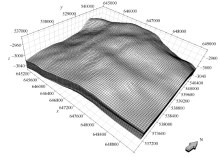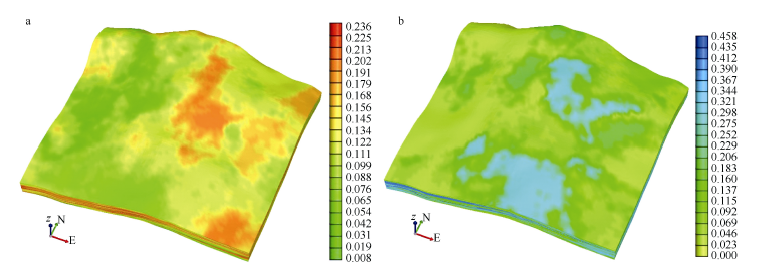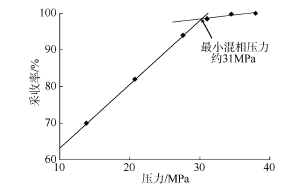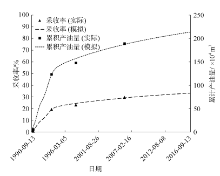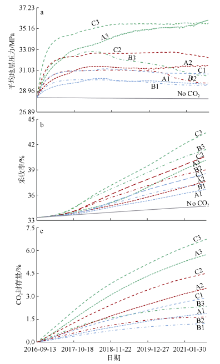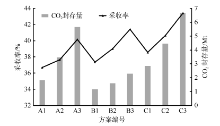Journal of Tropical Oceanography ›› 2017, Vol. 36 ›› Issue (5): 72-82.doi: 10.11978/2017005CSTR: 32234.14.2017005
• Orginal Article • Previous Articles Next Articles
Simulation of CO2-EOR-S in an offshore sandstone reservoir with strong bottom water
Xueyan LIU1,2( ), Pengchun LI1, Di ZHOU1, Jiemin LU3, Guanghao CHEN1
), Pengchun LI1, Di ZHOU1, Jiemin LU3, Guanghao CHEN1
- 1. CAS Key Laboratory of Ocean and Marginal Sea Geology, South China Sea Institute of Oceanology, Guangzhou 510301, China
2. University of Chinese Academy of Sciences, Beijing 100049, China
3. Bureau of Economic Geology, The University of Texas at Austin, Texas 78758, USA
-
Received:2017-01-06Revised:2017-03-28Online:2017-09-20Published:2017-09-22 -
About author:Author:QIU Chunhua.E-mail:
qiuchh3@mail. sysu.edu.cn -
Supported by:National Natural Science Foundation of China (41372256);KeyLogic Project of U.S. Department of Energy
Cite this article
Xueyan LIU, Pengchun LI, Di ZHOU, Jiemin LU, Guanghao CHEN. Simulation of CO2-EOR-S in an offshore sandstone reservoir with strong bottom water[J].Journal of Tropical Oceanography, 2017, 36(5): 72-82.
share this article
Add to citation manager EndNote|Reference Manager|ProCite|BibTeX|RefWorks
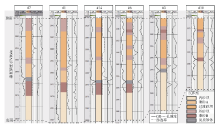
Fig. 4
Well section for M10 reservoir with logging interpretation results. Curves from left to right are GR, sub-facies, permeability and porosity, respectively. GR data of #1 were based on Peng et al (2013) and the other five GR curves are based on the General Editorial Committee of Oil and Gas Field Development in China (2013). The black horizontal dotted line marks the top and bottom of M10 reservoir"


Fig. 7
Relative permeability curves of oil-gas-water phases and capillary curves based on field data (a) and modified process (b). Pcow is oil-water capillary pressure, Krw is relative permeability of water, Krow is oil relative water permeability, Pcog is gas-liquid capillary pressure, Krg is relative permeability of gas, and Krog is oil relative to gas permeability"
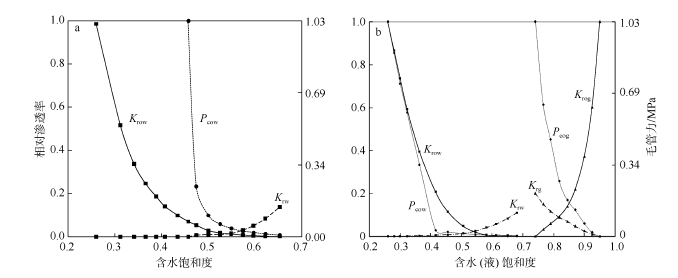

Fig. 9
Contour maps of simulated results. Oil saturation distribution in 1990 (a) and at the beginning of CO2 injection in 2016 (b). The black dots represent production wells with two designed CO2 injection wells of I1 and I2. The CO2-EOR-S simulated process begun in September 2016 after injection wells were opened"
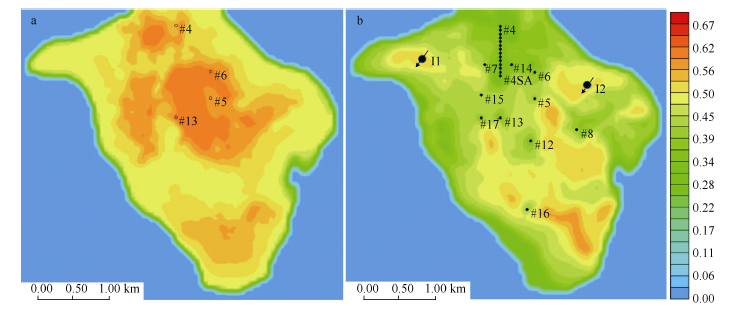
Tab.3
CO2 injection settings"
| 编号 | 注入井 | 注入压力/MPa | 平均地层压力/MPa | 驱替 机制 | 注入速率/(PV·a-1) | 注入HCPV |
|---|---|---|---|---|---|---|
| A1 | I1 | 35 | 29.85 | 非混相 | 0.010 | 0.399 |
| A2 | I1 | 38 | 30.99 | 近混相 | 0.016 | 0.621 |
| A3 | I1 | 41 | 33.72 | 混相 | 0.023 | 0.905 |
| B1 | I2 | 35 | 29.79 | 非混相 | 0.009 | 0.342 |
| B2 | I2 | 38 | 30.41 | 近混相 | 0.012 | 0.489 |
| B3 | I2 | 41 | 31.67 | 混相 | 0.020 | 0.789 |
| C1 | I1&I2 | 35 | 30.94 | 近混相 | 0.015 | 0.594 |
| C2 | I1&I2 | 38 | 32.26 | 混相 | 0.022 | 0.865 |
| C3 | I1&I2 | 41 | 34.69 | 混相 | 0.031 | 1.252 |
Tab.4
CO2 sequestration queuing of nine cases"
| 编号 | 采收 率/% | 采收率提高程度/% | 累积CO2 注入量/Mt | 累积CO2 生产量/Mt | CO2封存 量/Mt |
|---|---|---|---|---|---|
| A1 | 36.69 | 2.01 | 2.581 | 0.767 | 1.814 |
| A2 | 37.64 | 2.96 | 4.241 | 0.776 | 3.466 |
| A3 | 40.16 | 5.48 | 6.650 | 0.984 | 5.665 |
| B1 | 37.35 | 2.67 | 2.195 | 1.034 | 1.161 |
| B2 | 39.01 | 4.33 | 3.293 | 1.687 | 1.606 |
| B3 | 41.41 | 6.73 | 5.593 | 3.298 | 2.295 |
| C1 | 38.56 | 3.88 | 3.874 | 1.034 | 2.840 |
| C2 | 40.64 | 5.96 | 5.969 | 1.520 | 4.450 |
| C3 | 43.41 | 8.73 | 9.222 | 2.558 | 6.663 |
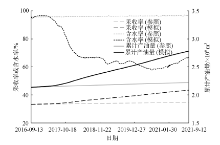
Fig. 12
Recovery factor, water cut and cumulative oil production curves of C3 case. The black line means stimulated results of CO2 injection, and the grey line is a reference with no CO2 injected. The curves of oil recovery factor, water cut and cumulative oil production correspond to long dashed, short dotted and solid lines, respectively"

| [1] | 毕凤琴, 李芳, 梁辉, 2011.“CO2-EOR”技术的国内外研究及应用现状[J]. 价值工程, 30(11): 206-207. |
| BI FENGQIN, LI FANG, LIANG HUI, 2011. Domestic and foreign research and application progress on CO2-EOR technology[J]. Value Engineering, 30(11): 206-207 (in Chinese). | |
| [2] | 陈澜, 梁希, 周蒂, 2014. 发展碳捕集、利用与封存对广东的产业机会[J]. 南方能源建设, 1(1): 7-15. |
| CHEN LAN, LIANG XI, ZHOU DI, 2014. Potential economic opportunities of developing a CCUS industry in Guangdong[J]. Energy Construction, 1(1): 7-15 (in Chinese). | |
| [3] | 陈维涛, 杜家元, 龙更生, 等, 2012. 珠江口盆地惠州地区珠江组控砂机制及地层-岩性圈闭发育模式[J]. 石油与天然气地质, 33(3): 449-458. |
| CHEN WEITAO, DU JIAYUAN, LONG GENGSHENG, et al, 2012. Factors controlling sandbody development and models of stratigraphic-lithologic traps of Zhujiang Formation in Huizhou area, Pearl River Mouth Basin[J]. Oil & Gas Geology, 33(3): 449-458 (in Chinese). | |
| [4] | 杜宗君, 张荣明, 2000. 应用测井资料结合岩相计算储层渗透率[J]. 测井技术, 24(增): 521-523. |
| DU ZONGJUN, ZHANG RONGMING, 2000. Calculation of reservoir permeability using log data and litho-facies[J]. Well Logging Technology, 24(Suppl): 521-523 (in Chinese). | |
| [5] | 郝敏, 宋永臣, 2010. 利用CO2提高石油采收率技术研究现状[J]. 钻采工艺, 33(4): 59-63. HAO MIN, SONG YONGCHEN, 2010. Research status of CO2-EOR[J]. Drilling & Production Technology, 33(4): 59-63 (in Chinese). |
| [6] | 雷霄, 胡余, 梁文锋, 等, 2015. 文昌19-1油田珠江组二段Ⅰ油组沉积相研究[J]. 西南石油大学学报(自然科学版), 37(4): 1-12. |
| LEI XIAO, HU YU, LIANG WENFENG, et al, 2015. A Study on Sedimentary Facies of Oil Group I in Member 2 of Zhujiang Formation in Wenchang 19-1 Oilfield[J]. Journal of Southwest Petroleum University (Science & Technology Edition), 37(4): 1-12 (in Chinese). | |
| [7] | 刘恒, 高树堂, 1995. 大庆油田开发先导性矿场试验[M]. 北京: 石油工业出版社. |
| [8] | 罗二辉, 胡永乐, 李保柱, 等, 2013. 中国油气田注CO2提高采收率实践[J]. 特种油气藏, 20(2): 1-7. |
| LUO ERHUI, HU YONGLE, LI BAOZHU, et al, 2013. Practices of CO2 EOR in China[J]. Special Oil and Gas Reservoirs, 20(2): 1-7 (in Chinese). | |
| [9] | 彭佳龙, 陈广浩, 周蒂, 等, 2013. 珠江口盆地惠州21-1构造二氧化碳地质封存数值模拟[J]. 海洋地质前沿, 29(9): 59-70. |
| PENG JIALONG, CHEN GUANGHAO, ZHOU DI, et al, 2013. Numerical simulation for offshore storage of carbon dioxide in Huizhou 21-1 trap, Pearl River Mouth Basin, China[J]. Marine Geology Frontiers, 29(9): 59-70 (in Chinese). | |
| [10] | 秦积舜, 韩海水, 刘晓蕾, 2015. 美国CO2驱油技术应用及启示[J]. 石油勘探与开发, 42(2): 209-216. |
| QIN JISHUN, HAN HAISHUI, LIU XIAOLEI, 2015. Application and enlightenment of carbon dioxide flooding in the United States of America[J]. Petroleum Exploration and Development, 42(2): 209-216 (in Chinese). | |
| [11] | 沈平平, 江怀友, 陈永武, 等, 2007. CO2注入技术提高采收率研究[J]. 特种油气藏, 14(3): 1-4, 11, 104. |
| SHEN PINGPING, JIANG HUAIYOU, CHEN YONGWU, et al, 2007. EOR study of CO2 injection[J]. Special Oil and Gas Reservoirs, 14(3): 1-4, 11, 104 (in Chinese). | |
| [12] | 沈平平, 廖新维, 2009. 二氧化碳地质埋存与提高石油采收率技术[M]. 北京: 石油工业出版社. |
| [13] | 施和生, 于兴河, 1999. 珠江口盆地(东部)砂岩油田沉积相研究及其应用[J]. 中国海上油气(地质), 13(3): 181-188. |
| SHI HESHENG, YU XINGHE, 1999. A study on sedimentary facies of sandstone oil fields in eastern Pearl River Mouth Basin[J]. China Offshore Oil and Gas (Geology), 13(3): 181-188 (in Chinese). | |
| [14] | 孙枢, 2006. CO2地下封存的地质学问题及其对减缓气候变化的意义[J]. 中国基础科学, 8(3): 17-22. |
| SUN SHU, 2006. Geological problems of CO2 underground storage and its significance on mitigating climate change[J]. China Basic Science, 8(3): 17-22 (in Chinese). | |
| [15] | 翟光明, 王善书, 1990. 中国石油地质志: 卷十六: 沿海大陆架及毗邻海域油气区(下)[M]. 北京: 石油工业出版社. |
| [16] | 张晓宇, 成建梅, 刘军, 等, 2006. CO2地质处置研究进展[J]. 水文地质工程地质, 33(4): 85-89. |
| ZHANG XIAOYU, CHENG JIANMEI, LIU JUN, et al, 2006. An overview of underground sequestration of carbon dioxide[J]. Hydrogeology & Engineering Geology, 33(4): 85-89 (in Chinese). | |
| [17] | 周蒂, 2005. CO2的地质存储——地质学的新课题[J]. 自然科学进展, 15(7): 782-787. |
| [18] | 祝春生, 程林松, 2007. 低渗透油藏CO2驱提高原油采收率评价研究[J]. 钻采工艺, 30(6): 55-57. |
| ZHU CHUNSHENG, CHENG LINSONG, 2007. Research on CO2 flooding in low permeability reservoir[J]. Drilling & Production Technology, 30(6): 55-57 (in Chinese). | |
| [19] | 朱伟林, 米立军, 2010. 中国海域含油气盆地图集[M]. 北京: 石油工业出版社. |
| [20] | 《中国油气田开发志》总编纂委员会, 2013. 中国油气田开发志——南海东部油气区油气田卷[M]. 北京: 石油工业出版社. |
| [21] | AZZOLINA N A, NAKLES D V, GORECKI C D, et al, 2015. CO2 storage associated with CO2 enhanced oil recovery: A statistical analysis of historical operations[J]. International Journal of Greenhouse Gas Control, 37: 384-397. |
| [22] | FERTL W H, FROST E JR, 1980. Evaluation of shaly clastic reservoir rocks[J]. Journal of Petroleum Technology, 32(9): 1641-1646. |
| [23] | ETTEHADTAVAKKOL A, LAKE L W, BRYANT S L, 2014. CO2-EOR and storage design optimization[J]. International Journal of Greenhouse Gas Control, 25: 79-92. |
| [24] | HILL B, HOVORKA S, MELZER S, 2013. Geologic carbon storage through enhanced oil recovery[J]. Energy Procedia, 37: 6808-6830. |
| [25] | IPCC, 2014. Climate Change 2014: Synthesis Report. Contribution of Working Groups I, II and III to the Fifth Assessment Report of the Intergovernmental Panel on Climate Change[R]. Geneva: IPCC: 1-151. |
| [26] | JIAO Z S, ZHOU L F, GAO R M, et al, 2014. Opportunity and challenges of integrated enhanced oil recovery using CO2 flooding with geological CO2 storage in the Ordos basin, China[J]. Energy Procedia, 63: 7761-7771. |
| [27] | KUUSKRAA V A, GODEC M L, DIPIETRO P, 2013. CO2 utilization from “next generation” CO2 enhanced oil recovery technology[J]. Energy Procedia, 37: 6854-6866. |
| [28] | KUUSKRAA V A, WALLACE M, 2014. CO2-EOR set for growth as new CO2 supplies emerge[J]. Oil & Gas Journal, 112(4): 92-105. |
| [29] | Computer Modelling Group LTD., 2015. CMG GEM User’s Guide[Z]. |
| [30] | MOGBO O, 2011. CO2 EOR and sequestration in a depleted gas-condensate reservoir: UKNS case study[R]. SPE 150752, Abuja: Society of Petroleum Engineers: 1-17. |
| [31] | SCHLUMBERGER, 2015. Petrel online help and manuals[Z]. |
| [32] | VAHIDI A, AHMADI M, NOURMOHAMMAD A, 2014. Carbon dioxide minimum miscibility pressure estimation (case study)[J]. Journal of Petroleum Science and Technology, 4(2): 20-27. |
| [33] | ZHAO D F, LIAO X W, YIN D D, 2014. Evaluation of CO2 enhanced oil recovery and sequestration potential in low permeability reservoirs, Yanchang Oilfield, China[J]. Journal of the Energy Institute, 87(4): 306-313. |
| No related articles found! |
|
||






